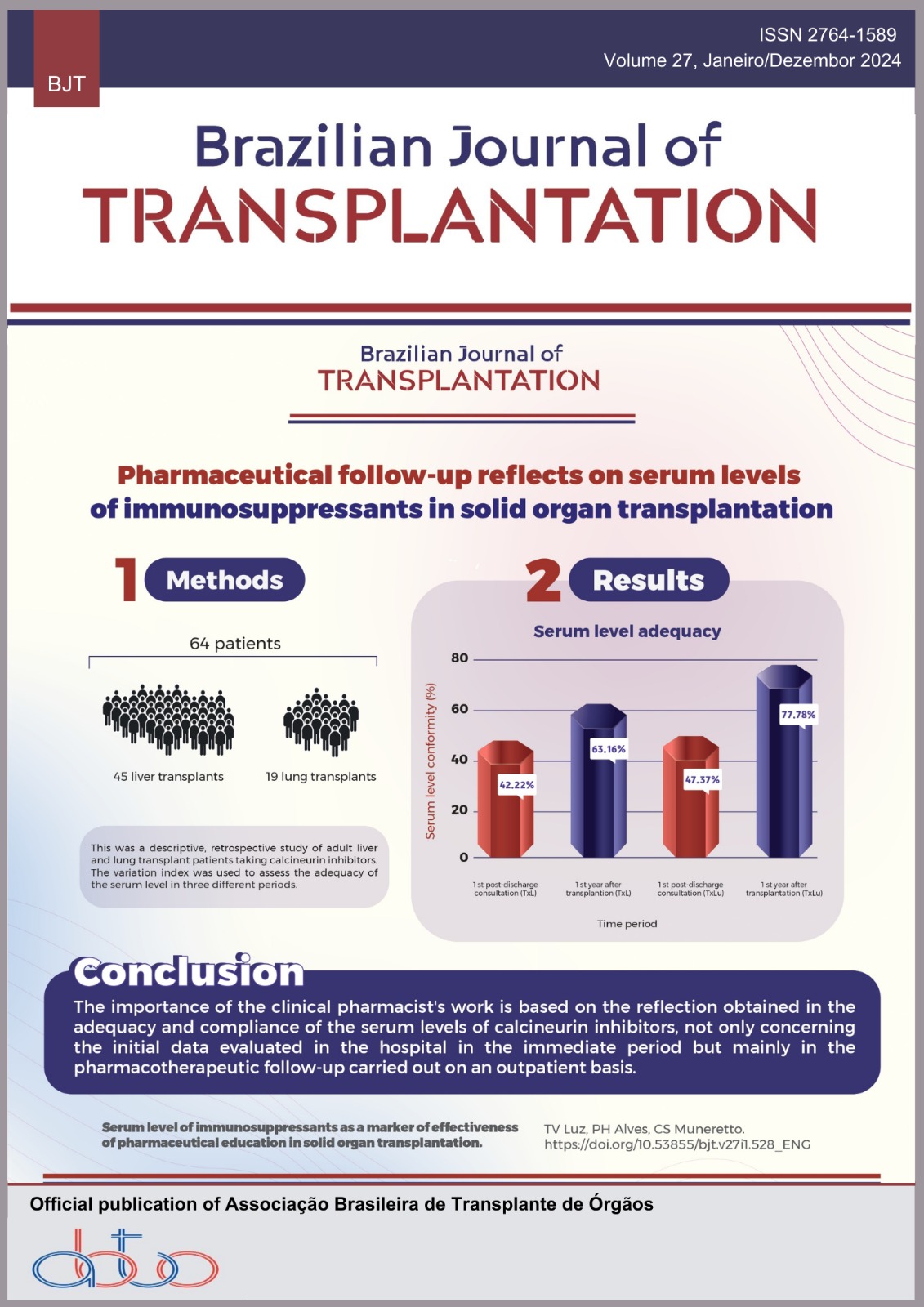Association of Therapeutic Monitoring of Tacrolimus with Laboratory Markers of Kidney Function in Receptors of Kidney Allograft
Keywords:
Tacrolimus, Kidney Transplantation, Drug Toxicity, Drug MonitoringAbstract
Introduction: Kidney transplantation is the most commonly performed type of transplant in Brazil. Tacrolimus is one of the primary drugs used in post-transplant immunosuppressive therapy, and one of its main adverse effects is nephrotoxicity. Laboratory tests to assess renal function are of great importance in monitoring post-kidney transplant patients, helping to diagnose events indicative of graft dysfunction. Objective: The present study aimed to evaluate the association between laboratory changes in renal function and blood levels of tacrolimus in post-kidney transplant patients. Methods: Observational, analytical and cross-sectional study. The results of blood levels of tacrolimus and measurements of urea, creatinine and estimated Glomerular Filtration Rate (eGFR) were analyzed, as well as the sociodemographic data of kidney transplant recipients followed at a university hospital who underwent laboratory tests between months from January 2021 to July 2022 in a period close to 1 year after the transplant. The variables analyzed in the research were collected from the patient's medical records and subsequently analyzed; the statistical analyses considered p < 0.05. The project was approved by the Ethics Committee of the Walter Cantídio University Hospital under opinion number 5,436,434 and CAAE number 57396622.1.0000.5045. Results: The sample was mainly composed of males, mixed race, with an average age of 51.5 years (SD ± 12.5) and from cities in the interior of Ceará. Regarding the percentage of patients with laboratory changes, 50.62% (n = 45) showed changes in tacrolimus blood levels. 56.79% (n = 46) had changes in serum creatinine levels, 49.38% (n = 40) had changes in serum urea levels, and 59.26% (n = 48) had altered eGFR. The correlation analyses suggested a low significance between variations of the variables studied. Conclusion: The results indicate no relationship between variations in tacrolimus blood concentrations and the appearance of changes in the results of classic renal biomarkers at the end of the first year post-transplant. However, it is necessary to carry out new studies to understand better the impact of changes in blood levels of tacrolimus on the renal function of renal allograft recipients.
Downloads
References
Tessmer MGS, Mielke GI, Barcellos FC, Moraes BP de, Gatto CST. Doação de órgãos: opinião e entendimento sobre morte encefálica de estudantes universitários. Braz J Transplant. 2011; 14(1): 1466–1471. https://doi.org/10.53855/bjt.v14i1.192
Soares LSS, Brito ES, Magedanz L, França FA, Araújo WN, Galato D. Transplantes de órgãos sólidos no Brasil: estudo descritivo sobre desigualdades na distribuição e acesso no território brasileiro, 2001-2017. Epidemiol Serv Saude 2020; 29(1): e2018512. https://doi.org/10.5123/S1679-49742020000100014
Brasil. Ministério da Saúde. Protocolo Clínico e Diretrizes Terapêuticas para Imunossupressão em Transplante Renal. Brasília, 2020. [access on 15 Jun 2022]. Available in: https://gov.br/conitec/pt-br/midias/consultas/relatorios/2020/relatorio_pcdt_imunossupressao_em_transplante_renal_cp_28_2020.pdf.
Associação brasileira de transplante de órgãos. Dimensionamento dos Transplantes no Brasil e em cada estado (2014-2021). Registro Brasileiro de Transplantes. São Paulo, Ano XXVIII, 2021 [access on 16 Jun 2022];4: 8. Available in: https://site.abto. org.br/wp-content/uploads/2022/03/leitura_compressed-1.pdf.
Silva JM, Fialho AVM, Borges MCLA, Silva LMS. Perfil epidemiológico dos pacientes transplantados renais em hospital universitário e o conhecimento sobre o uso de drogas imunossupressoras. Braz J Transplant 2011; 14(1): 1456–1459. https://doi.org/10.53855/bjt.v14i1.190
Bentata, Y. Tacrolimus: 20 years of use in adult kidney transplantation. What we should know about its nephrotoxicity. Artif Organs 2020; 44(2): 140-152. https://doi.org/10.1111/aor.13551
Porto JR, Gomes KB, Fernandes AP, Domingueti CP. Avaliação da função renal na doença renal crônica. Rev Bras Anal Clínic 2017; 49(1): 26-35. https://doi.org/10.21877/2448-3877.201500320
Dusse LMS, Rios DRA, Sousa LPN, Sousa RMMS, Domingueti CP, Gomes KB. Biomarcadores da função renal: do que dispomos atualmente? Rev Bras Anal Clínic 2017; 49(1): 41-51. https://doi.org/10.21877/2448-3877.201600427
Marconi MA, Lakatos EM. Metodologia do trabalho científico. São Paulo: Atlas; 2003.
Universidade Federal do Ceará (UFC). Hospital Universitário é referência no Norte e Nordeste na política de transplantes do Brasil. Notícia. 2023. [acess on 15 Ago 2024]. Available in: https://ufc.br/noticias/noticias-de-2023/18136-hospital- universitario-e-referencia-no-norte-e-nordeste-na-politica-de-transplantes-do-brasil#:~:text=Em%202020%2C%20o%20HUWC%20havia,totalizando%20151%20cirurgias%20dessa%20natureza.
Universidade Federal do Ceará (UFC). Hospital Universitário Walter Cantídio (HUWC). Protocolo do Transplante Renal. Fortaleza, 2019.
Kidney Disease: Improving Global Outcomes (KDIGO). CKD WORK GROUP. KDIGO 2012 Clinical Practice Guideline for the Evaluation and Management of Chronic Kidney Disease. Kidney Int (Suppl), 2013; 3(Issue 1): 1–150.
Oliveira LSV, Vietta GG, Kretzer MR, Machado JS. Perfil sociodemográfico e clínico de pacientes com transplante renal e os fatores associados à rejeição do órgão transplantado em um hospital filantrópico de Florianópolis. Dissertation [Graduation in Nursing] - Universidade do Sul de Santa Catarina; 2020. https://repositorio.animaeducacao.com.br/handle/ANIMA/4886
Mota MU. Qualidade de vida em pacientes transplantados renais assistidos em um hospital universitário. Dissertation [Master in Public Health] – Universidade Estadual do Ceará; 2015. https://siduece.uece.br/siduece/trabalhoAcademicoPublico. jsf ?id=84254
Batista CMM, Moreira RSL, Pessoa JLE, Ferraz AS, Roza BA. Perfil epidemiológico dos pacientes em lista de espera para o transplante renal. Acta Paulist Enferm 2017; 30(3); 280–286. https://doi.org/10.1590/1982-0194201700042
Alghanem SS, Soliman MM, Alibrahim AA, Gheith O, Kenawy AS, Awad A. Monitoring Tacrolimus Trough Concentrations During the First Year After Kidney Transplantation: A National Retrospective Cohort Study. Front in Pharmacol 2020; 11(8); 1–10. https://doi.org/10.3389/fphar.2020.566638
Lira ALBC. Diagnósticos de enfermagem em pacientes transplantados renais de um hospital universitário de Fortaleza-CE. Dissetation [Master in Nursing] – Universidade Federal do Ceará; 2005. http://repositorio.ufc.br/handle/riufc/1953
Kashani K, Rosner MH, Ostermann M. Corrigendum to Creatinine: From physiology to clinical application. Eur J Intern Med 2023; 116: 168–169. https://doi.org/10.1016/j.ejim.2023.07.025
Liu F, Guanhui M, Chao T, Shan Z, Xinghua Y, Cong X, Weihao Y, Guobao X, Mingliang L. Elevated Blood Urea Nitrogen- To-Creatinine Ratio Increased the Risk of Coronary Artery Disease in Patients Living with Type 2 Diabetes Mellitus.” BMC Endocr Disord 2022; 22(1): 1-10. https://doi.org/10.1186/s12902-022-00954-3
Downloads
Published
How to Cite
Issue
Section
License
Copyright (c) 2024 Livia de Oliveira Albuquerque , Alene Barros de Oliveira, Francinaldo Filho Castro Monteiro, Tiago Lima Sampaio, Ramon Róseo Paula Pessoa Bezerra de Menezes

This work is licensed under a Creative Commons Attribution 4.0 International License.









